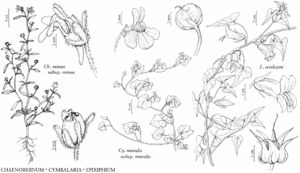Cymbalaria muralis subsp. muralis
Perennials 10–60 cm. Leaves: petiole 10–22 mm; blade 5–40 × 6–60 mm, surfaces glabrous or with scattered hairs. Pedicels ascending, 10–35 mm in flower, recurved, to 90 mm in fruit. Flowers: sepals equal, lobes 1.5–3 × 0.5–1 mm, apex acute; corolla-tube 3–5 mm, glabrous, palate inflated, abaxial plicae yellow, lobes: abaxial spreading, adaxial erect, subequal, 2–3 mm, apex round; stamens included, filaments incurved, abaxial 2–4 mm, adaxial 3–5 mm, pollen-sacs oblong; ovary glabrous, locules subequal; style included, 3–4 mm, base persistent in fruit; stigma straight. Capsules globular, 3–5 mm. Seeds 0.5–1 mm, cristate-tuberculate. 2n = 14.
Phenology: Flowering May–Oct.
Habitat: Rock walls, rocky disturbed sites.
Elevation: 0–400 m.
Distribution
Introduced; B.C., Man., N.B., Ont., Que., Ark., Calif., Colo., Conn., Del., Ill., Ind., Ky., Md., Mass., Mich., Mo., Nebr., N.J., N.C., Ohio, Oreg., Pa., S.C., S.Dak., Tenn., Vt., Va., Wash., W.Va., Wis., s Europe, also in Mexico, Central America, South America, Asia, Africa, Atlantic Islands, Pacific Islands, Australia
Discussion
Subspecies muralis occurs to 2000 m elevation outside the flora area.
Selected References
None.
Lower Taxa
"elongating" is not a number.
